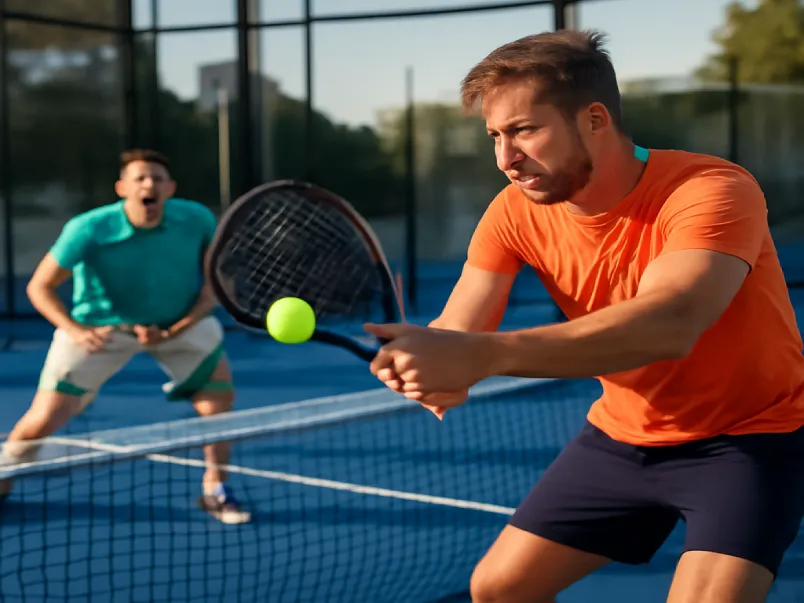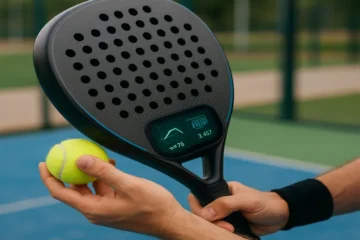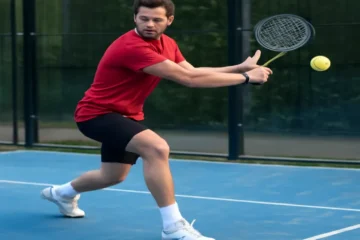I. The Sound of a New Racket
As the familiar rhythmic “pop” of pickleball paddles echoes across courts nationwide, a new, distinct sound is beginning to be heard in the world of racket sports. It’s a deeper, more resonant “thud,” signaling the arrival of a sport that is quietly—but quickly—gaining momentum: padel. For those unfamiliar, padel is often described as a dynamic mix of tennis and squash, and it’s growing at an explosive rate across Europe and Latin America. Now, it’s making its way to the U.S., with 2025 positioning itself as a pivotal year for padel’s American breakout.
What is Padel? To put it simply, padel is a fast-paced sport played on an enclosed court about one-third the size of a tennis court. Players use solid rackets to hit a ball over a net, with the added twist that the walls are in play, allowing for bounces off them, much like squash. While it may look like a hybrid of tennis and pickleball, padel has its unique charm and an appeal that is quickly making it one of the fastest-growing sports globally.
Thesis Statement: While padel isn’t set to overtake pickleball overnight, 2025 is likely to see a significant surge in its popularity in the United States, driven by major investments, a post-pickleball hunger for new racket sports, and a growing interest in more social, accessible athletic activities.
II. What Exactly is Padel? The Recipe for Its Appeal
To truly understand padel’s appeal, it’s essential to break down its core components—the court, the rules, and what makes it so universally loved.
A. The Court & The Rules: Simple Yet Strategic
One of the first things you’ll notice about padel is the court. It’s much smaller than a tennis court, measuring about one-third the size of a standard court, which makes it more accessible for people of all ages and physical abilities. The court is enclosed by glass walls, and the key feature is that these walls are in play. Players can hit the ball off the walls in a way that extends rallies and adds an element of strategy and excitement that you won’t find in tennis.
Padel matches are played in doubles format (two players on each side), which fosters a highly social atmosphere. The underhand serve and the double-bounce rule—where the ball must bounce once on the ground and then off the wall before being returned—make the game much easier to pick up compared to tennis, which has more complex serving and scoring rules. These features combine to create a game that’s both approachable for newcomers and still challenging for seasoned players.
B. Why People Love It: The Core Strengths
What truly sets padel apart is how fun and accessible it is.
- Easy to Learn, Hard to Master: Because the rules are simple, beginners can quickly pick up padel and enjoy a solid match. However, as players gain experience, the game becomes more strategic, offering a depth that keeps players coming back.
- Highly Social: Padel is predominantly played in doubles, meaning you’re always playing with a partner. This creates an environment of camaraderie and interaction that is one of the sport’s biggest draws. It’s a sport that’s perfect for social gatherings and friendly competition.
- The Fun Factor: The use of walls in padel makes for exciting, dynamic rallies. Unlike tennis, where the ball typically bounces only once before being returned, the walls in padel allow for longer, more engaging points. These can even result in spontaneous and often hilarious exchanges, making the game enjoyable for players and spectators alike.
- Less Physically Demanding: The smaller court size and less emphasis on long sprints make padel a game that’s less physically demanding than tennis. This lowers the barrier for people of various ages and fitness levels to participate, making it an inclusive sport.
III. The Case FOR the Surge: Fueling the Padel Engine in 2025
Padel’s momentum in the U.S. is not just based on its appeal as a sport. Several key factors are contributing to its rapid growth and the possibility that 2025 could be a tipping point for the sport’s popularity in America.
A. The Pickleball Pipeline: The Natural Next Step
The massive popularity of pickleball in the U.S. has primed the public for alternative racket sports. Pickleball, known for its accessibility and low learning curve, has surged in recent years, particularly among older adults. However, many players who’ve mastered pickleball are looking for something new and challenging. Padel, with its mix of tennis and squash elements, provides a natural progression for those who want to take their racket sport experience to the next level. This growing community of racket sport enthusiasts is a perfect target audience for padel’s expansion.
B. Major Financial Backing: Investments Fuel Growth
Padel has garnered significant financial backing from high-profile investors, including NFL star Tom Brady, Formula 1 driver Lando Norris, and various investment firms. These figures bring not only capital but also credibility and marketing power to the sport. As these influential figures get behind padel, the sport is gaining more visibility and legitimacy, making it even more enticing for potential players and facilities to get involved.
C. Strategic Facility Expansion: The Rise of Padel Clubs
As demand for padel increases, so does the number of dedicated facilities. Padel courts are being built in major cities like Miami, New York City, Los Angeles, and Austin, with plans to expand further in both urban and suburban areas. This is crucial because the infrastructure necessary to support padel—courts, clubs, and training facilities—has historically been a significant barrier to entry. As more padel-specific venues open up, the sport will become more accessible to people across the country.
Additionally, existing tennis courts are being converted into padel courts, which is a cost-effective solution for facility owners looking to capitalize on the growing trend. These strategic moves help padel build the infrastructure it needs to sustain its growth.
D. The Power of Media & Celebrity Endorsements
Padel’s rise is also fueled by its presence in mainstream media and the support of celebrity endorsements. International sports stars like Lionel Messi and David Beckham have publicly embraced padel, creating a ripple effect that boosts the sport’s cool factor. Social media platforms are also playing a major role in this, with viral videos and influencers showcasing the excitement of padel matches. As the sport continues to gain attention, more players, particularly younger demographics, will be inspired to pick up a racket.
IV. The Hurdles to Overcome: Challenges on the Road to Mainstream
While the growth potential for padel is undeniable, there are still challenges standing in the way of its widespread acceptance in the U.S.
A. The “But We Have Pickleball” Problem
One of the biggest hurdles padel faces is the sheer dominance of pickleball. The sport has exploded in popularity, especially in the last few years, and has become the go-to alternative to tennis. Many Americans are still deeply invested in pickleball, which means convincing players, facility owners, and investors to adopt padel might prove difficult. However, as pickleball players look for something more challenging, padel could easily fill that gap.
B. The Infrastructure Gap
Building dedicated padel courts is not a simple task. It requires a significant investment in both space and resources, and the cost of constructing a proper padel court is much higher than simply painting pickleball lines on a tennis court. This creates a barrier to entry for many communities and facility owners who are hesitant to invest in yet another sport. As demand grows, however, the potential for funding and grants to help offset these costs becomes more likely.
C. Awareness & The “Name” Problem
One of the most significant obstacles padel faces in America is a lack of awareness. Many people in the U.S. still don’t know what padel is, and when they hear the name, it’s often confused with other racket sports like paddle tennis or platform tennis. Marketing efforts will need to focus on creating clarity around what padel is, how it differs from other racket sports, and why it’s so enjoyable.
V. 2025: The Tipping Point? Key Indicators to Watch
As 2025 unfolds, there are several key indicators to keep an eye on to determine whether padel is truly on the verge of breaking into the American mainstream.
A. The “Platform” Model
Padel’s emergence in the U.S. could mirror the rise of social clubs and membership-based platforms like The Padel Club or Casa Padel. These venues offer more than just a place to play—they create a community. If these clubs can establish a loyal following, it will be a strong indicator that padel is here to stay.
B. From Participation to Spectation
As the number of players grows, padel will likely begin to see the development of professional leagues and tournaments, such as Premier Padel, which will be broadcasted on U.S. platforms. This will help transition padel from a niche activity to a spectator sport, further solidifying its place in American sports culture.
C. Data & Demographics
Tracking the growth of padel courts, clubs, and player participation will be essential to gauge the sport’s trajectory in 2025. If these metrics see significant growth, it will signal that the sport is ready for mainstream acceptance.
VI. Conclusion: The Verdict on the Padel Surge
To recap, padel is poised for growth in the U.S. in 2025, thanks to favorable tailwinds like investments, the success of pickleball, and the increasing number of dedicated facilities. However, it will need to overcome challenges like the dominance of pickleball, infrastructure gaps, and low awareness. While padel may not experience the same explosive rise as pickleball, it will undoubtedly make significant strides, especially in major metropolitan areas.
The 2025 Forecast: Padel is set to experience a surge in popularity, particularly in urban centers. It won’t reach pickleball-levels of penetration just yet, but it will solidify its place as the next major racket sport in the U.S. Will you be one of the first to pick up a racket?
FAQs
1. What is padel?
Padel is a racket sport that combines elements of tennis and squash. It’s played on an enclosed court about one-third the size of a tennis court, with walls that players can use to bounce the ball off, similar to squash. The game is typically played in doubles format, making it a highly social and dynamic experience.
2. Why is padel growing so quickly?
Padel is growing rapidly because of its unique blend of accessibility and excitement. It’s easy to learn but challenging to master, making it appealing to both beginners and experienced players. Additionally, the rise of pickleball in the U.S. has paved the way for more alternative racket sports, and padel is poised to capitalize on that demand.
3. How is padel different from pickleball?
While both are popular racket sports, padel is played on a smaller enclosed court, and players can use the walls to their advantage, much like squash. Padel also features an underhand serve and double-bounce rule, making the gameplay distinct from pickleball. Additionally, padel is typically played in doubles, making it more social.
4. Where is padel most popular?
Padel is extremely popular in countries like Spain, Sweden, and Argentina. It’s seen significant growth in Europe and Latin America, and the sport is now starting to make a splash in the U.S., with new courts and clubs opening in major cities.
5. Will padel replace pickleball in the U.S.?
While it’s unlikely that padel will replace pickleball, it is expected to grow alongside it. The success of pickleball has created a larger market for racket sports, and padel offers a fresh challenge for players who are looking for something new. Both sports can coexist and thrive in the U.S. market.
6. Is padel accessible for beginners?
Yes, padel is known for its low barrier to entry. The rules are simple, and the game is easy to pick up. However, like tennis, there is a high skill ceiling, so players can continue to improve and challenge themselves as they progress.
7. What’s the future of padel in the U.S.?
Padel’s future in the U.S. looks promising. With significant investments, growing facilities, and increasing media coverage, 2025 is expected to be a pivotal year for the sport’s growth. While it may not reach the popularity of pickleball in the immediate future, padel is set to establish itself as a major contender in the racket sports scene.




